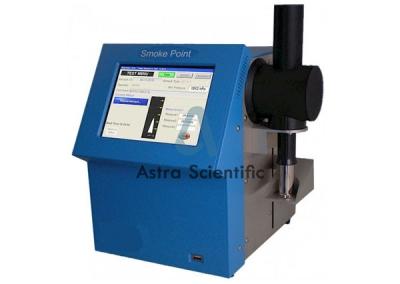
Description and Specification for Lab Tenders
Automatic Smoke Point Apparatus.
The Smoke Point method, in accordance with ASTM D1322, IP 598, is one of the oldest test methods in the petroleum industry. This test method provides an indication of the relative smoke producing properties of kerosenes and aviation turbine fuels in a diffusion flame. The smoke point is related to the hydrocarbon composition of such fuels.
Generally, the more aromatic the fuel, the smokier the flame. A high smoke point indicates a fuel of low smoke producing tendency. Performing the smoke point test manually requires highly skilled technicians with years of experience. Additionally, the manual test is time consuming. The current visual rating method used for specification purposes suffers from the drawback of operator subjectivity. The visual measurement of an open flame is a challenging exercise and dangerous for lab personnel. The visual rating of the flame varies from one operator to another.
This unique automated instrument uses a patented system (License TOTAL RM) based on a video camera that measures the flame. The flame image is digitalized. The dedicated software determines the height of the flame when its shape corresponds to the one described in the test method. This specific flame is the one with the maximum height without smoke generation. The SP10 performs three determinations of the flame heights and reports the average value in strict accordance with the test method. The results are saved in an internal database and can be printed, transferred to a USB memory stick and/or sent to a LIMS. Every test is fully documented and traceable, which is imperative for aviation industry quality procedures.
The SP10 is an Automated Smoke Point instrument that strictly follows the test method while both eliminating the subjectivity inherent to the manual test and significantly improving repeatability and reproducibility. Additionally, the SP10 eliminates all safety risks linked to the visual observation of an open flame. The test can now be run unattended which drastically reduces labor costs.
| Technical Points | Description |
| Test duration | Less than 10 minutes |
| Resolution (flame height) | 0.1 mm |
| Repeatability and Reproducibility | r=0.6 and R=0.9 Four times better than manual test method (r=2.8 and R=3.8) |
| Parameters saved with a test result | Smoke point in 0.1 mm (according to selected test method), Sample type, Sample ID, Date and Time, Barometric pressure, Operator name, Test method, Calibration information, Instrument serial number, Software version |
| Results storage | Up to 100 000 results |
| LAN connectivity | Ethernet port RJ45 |
| Printer output | Serial port (printer is optional) |
| Data output | USB(2), Ethernet |
| Dimensions | W x D x H (mm): 330 x 390 x 413 W x D x H (inches): 13″ x 15″ x 16″ |
| Weight | 10kg (22lb) |
| Electrical | 112 to 230V – 2A – 50/60Hz |
The smoke point test with the is as simple as is a flash point test with an automated instrument. The operator prepares the candle according to the test method instructions (phase 1). The candle is then positioned on a conveyor (phase 2). The operator keys in all sample details and then initiate the test (phase 3).
Then all the procedure is automated. The candle is automatically lit, the five minutes stabilization time is followed by the three determinations of the flame height. At the end of test, the SP 10 instrument calculates the mean value of the three flame heights measured. The result is rounded then corrected with the memorized lamp correction factor and finally reported according to the format specified in the test method. The result is saved in a built-in data base. It can be printed, transferred on a USB memory stick and/or send to a LIMS when the SP 10 is connected to a LAN. The lamp factor correction is automatically calculated and used for result reporting.
